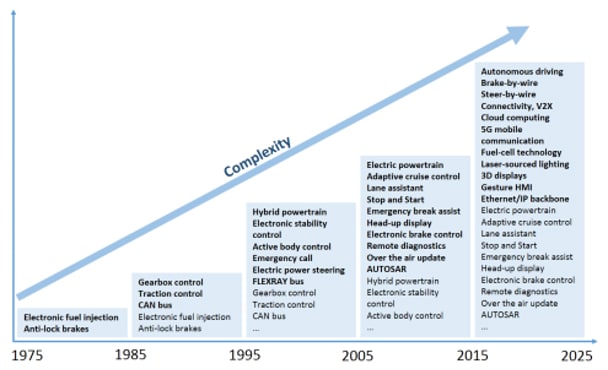)
L'architecture EE désigne la conception et l'organisation globales des systèmes électriques et électroniques qui contrôlent les différentes fonctions d'un véhicule et joue un rôle crucial dans les voitures modernes. En effet, elle implique l'intégration de divers systèmes tels que le contrôle du groupe motopropulseur, le contrôle du châssis, le contrôle de la carrosserie et les systèmes d'infodivertissement, entre autres, au sein d'un réseau unifié. Ce réseau est conçu pour assurer une communication et une coordination transparentes entre les différents composants, ce qui permet d'améliorer les performances, la sécurité et la fiabilité du véhicule.
L'architecture de l'EE comprend généralement des unités de traitement, des capteurs, des actionneurs, du câblage et divers protocoles de communication. L'architecture doit être conçue pour être hautement fiable et résiliente, ainsi que pour être évolutive et adaptable afin de répondre aux besoins changeants des véhicules modernes. L'utilisation de systèmes électriques et électroniques dans les voitures remonte au début du XXe siècle, avec l'introduction de démarreurs électriques, de phares et de systèmes d'allumage.
Cependant, l'architecture EE moderne telle que nous la connaissons aujourd'hui a commencé à prendre forme dans les années 1980, avec l'introduction d'unités de contrôle électronique (UCE) plus avancées, capables de gérer différents systèmes dans le véhicule. Dans les années 1990, avec la demande croissante de fonctions plus complexes et sophistiquées dans les véhicules, telles que les systèmes de sécurité avancés, la navigation et l'infodivertissement, l'architecture EE est devenue encore plus critique.
Cela a conduit au développement de protocoles de mise en réseau plus avancés tels que CAN (Controller Area Network) et LIN (Local Interconnect Network), qui ont permis une communication plus efficace et plus fiable entre les différents systèmes du véhicule. Depuis lors, l'architecture EE a continué à évoluer et est devenue encore plus complexe et sophistiquée, avec l'intégration de capteurs, de processeurs et de protocoles de communication plus avancés.
Aujourd'hui, l'architecture EE est un composant essentiel des voitures modernes, jouant un rôle vital pour garantir la sécurité, les performances et la fiabilité du véhicule.Il existe un lien étroit entre l'utilisation de l'architecture EE et le nombre de fonctionnalités d'une voiture. Il existe un lien étroit entre l'utilisation d'une architecture d'EE et le nombre de fonctions d'une voiture. À mesure que des fonctions sont ajoutées aux voitures modernes, la complexité des systèmes électriques et électroniques du véhicule augmente (voir image ci-dessous), ce qui rend nécessaire l'utilisation d'une architecture d'EE pour gérer et coordonner l'ensemble des différents systèmes et fonctions.
Par exemple, dans les voitures anciennes, il n'y avait généralement que quelques systèmes électriques de base comme le démarreur, les phares et le système d'allumage. Cependant, dans les voitures modernes, il existe une grande variété de systèmes et de fonctionnalités avancés tels que le contrôle moteur, le contrôle de la transmission, la direction assistée, le système de freinage antiblocage (ABS), le contrôle de traction, la climatisation, l'infodivertissement et les systèmes avancés d'aide à la conduite (ADAS).

La complexité croissante au fil du temps a entraîné l'évolution de l'architecture de l'EE, qui est passée des systèmes distribués aux contrôleurs de domaine, puis à l'architecture de l'EE zonale/centralisée utilisant diverses technologies de communication telles que LIN, CAN et Ethernet. Aujourd'hui, la gestion et la coordination de tous ces systèmes et fonctions nécessitent une architecture d'EE très sophistiquée, capable de gérer la complexité et d'assurer une communication et une coordination sans faille entre les différents composants. Par conséquent, plus une voiture possède de fonctions, plus son architecture EE doit être complexe et sophistiquée pour garantir une fonctionnalité et une fiabilité adéquates.